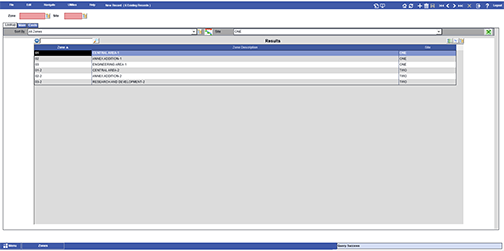Published: March 14, 2012 Updated: February 27, 2025
CMMS Zones: Taking Maintenance Management to the Next Level

Not all maintenance groups are the same; neither are all maintenance needs. Whether you’re Manufacturing, Facilities or Utilities, each group approaches their responsibilities differently. However, we all have one common goal: keeping the Unit running! Maximum uptime, Minimum downtime in a cost-effective manner is the order of the day.
Computerized Maintenance Management Systems (CMMS) have greatly improved the overall maintenance process. Work Orders, PMs, Equipment, and Inventory are all benefactors of a company's decision to manage these processes electronically.
Many computerized maintenance management systems offer "Sites" but only a few give you a feature called Zones that take this management to the next level. The Zones feature provides Logical and Physical Separation. In Logical Separation, you create a Zone for each Type of Equipment; Motors, Cranes, Cooling Towers, Pumps. Specific Crews (or Employees) that always work on this Equipment would have the same Zone as that equipment. Work for each Zone can be scheduled separately, while sharing common Inventory and Purchasing information.
Physical Separation: Maintenance Area-Based Zones
With Physical Separation, you create a Zone for each Maintenance Area. All Equipment/Locations, Crews or Employees would have the same Zone as the Maintenance Area to which they are assigned. Each Maintenance Area can be managed independently, while sharing common Inventory and Purchasing information.
Zones can be an effective solution to a maintenance organization having multiple, defined Crafts (Machinists, Pipefitters, Ironworkers, Masons, Carpenters) or a Centralized Maintenance group (Operations Support, Central Maintenance, Maintenance Planning & Scheduling) that handle specialized work not performed by the departments in-house Maintenance Crews (such as Millwrights or Motor Inspectors).
Applications of Zones in Diverse Maintenance Organizations
In the example shown above, Physical Separation using Equipment Hierarchy can be applied to each department or unit within the company; Blast Furnace, Caster, Mobile Equipment, Central Maintenance, Stores, Engineering, Accounting, Personnel. A department doesn't have its own crew of Maintenance employees to warrant having its own Zone (such as Engineering, Accounting, Personnel, or Stores).
Logical Separation is applied in the same manner. If you choose to identify your assets using Location Hierarchy (as opposed to Equipment) – Beecher Hall, Student Center, Main Campus – your Pump Repairmen, Electricians, and Crane Repair employees can have a unique Zone. Work Orders & PMs will carry the same Zone as the Location while the employees in each Repair Shop and their Stockrooms will have a different one.
Implementing Equipment and Location Hierarchies with Zones
Physical Separation has Primary and Secondary entities. Primary entities are Equipment – Locations – Crews – Employees. Each Equipment/Location and Crew/Employees must have a Zone defined. A Human Resource record is created for every employee in the Zone. Each employee in the Zone that is assigned to perform work on Equipment will have to have a Login record to the CMMS. Within the CMMS, Authority control is used to grant access to multiple Zones. Without multiple Zone access, users attach to their own Zone by default.
Primary and Secondary Zoned Entities: Defining Relationships
Secondary Zoned entities work automatically in conjunction with the Primary Zoned Entity. Whether you implement Crew or Craft designations for your employees is up to you and how you perform your daily work. Secondary entities, such as Work Orders, inherit their Zone from one of the four Primary Zoned Entities. WOs written against Routes inherit from the Route; Routes inherit their Zone from the user who created it. This is especially helpful when dealing with Crews. A Pump Repairman creates a Pump Lube Route for routine equipment maintenance. This Route inherits its Zone from the creator, and all WOs (including PM WOs) created for that Route will have the same Zone.
Solving Real-Time Maintenance Challenges with Zones
What kinds of problems can Zones solve for you? Consider the following real-time maintenance scenario that we faced at our plant:
- Blast Furnace Millwrights shouldn't have to page through Caster equipment records in order to do their job.
- "Just because the BOF generates PMs monthly doesn't mean the Caster has to."
- With 2100 people to pay every day, supervisors need a way to find their employees quickly!
Those are good examples of Primary Zoned entity problems we resolved with Zones. Here's a great example of Secondary Zoned problem that was effectively resolved:
- Mobile Equipment "owned" by Zone 26 (Steel Finishing) is maintained by employees in Zone 48 (Mobile Repair).
- Zone 48 Supervisors can issue a Work Order to Zone 52 (Central Maintenance) Machinists to make a new set of Clevis Pins.
- Zone 52 Machinists will charge time to a WO issued by Zone 48. Labor & Material charges impact Zone 26's monthly cost!
Benefits of Implementing CMMS Zones: A Summary
Whether your operation employs 21 or 2100 employees, selecting a Computerized Maintenance Management System that offers the Zones feature will provide the tools necessary to accurately capture costs. You can document where your resources are utilized, and which assets are demanding them.
In review:
- Zones permit Departmental Autonomy.
- Zones allow for Zone Administrators if desired.
- Zones define maintenance responsibility.
- Zones group / identify your workforce.
MAPCON CMMS software empowers you to plan and execute PM tasks flawlessly, thanks to its wealth of features and customizable options. Want to see it for yourself? Click the button below to get your FREE 30-day trial of MAPCON!
Try It FREE!